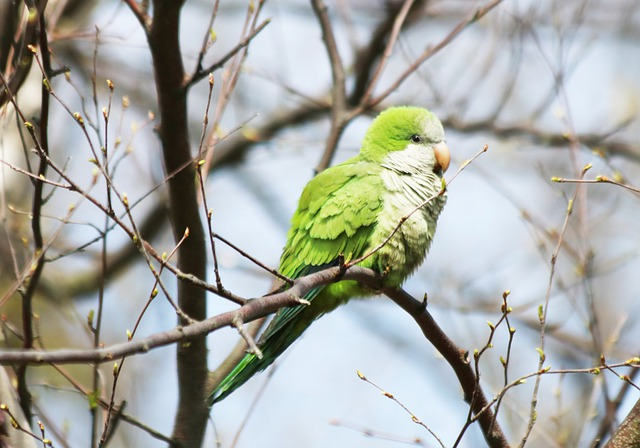Are you looking for a furry companion to match your fun energy and comical personality? You cannot go wrong with baby Quaker parrots. Baby Quakers are known to be little chatterboxes who enjoy being around humans. That is why they are a favorite pet among many bird lovers.

Taking care of a Quaker parrot is not for weak-willed individuals. Baby Quakers are a very social species of birds that value affection. They require a lot of your time and attention.
They can be quite a handful to manage, but rest assured your dedication will not go to waste. After all, Quakers will repay you with lots of love and fun times.
This guide can help you learn how to parent your baby Quaker!
Table of Contents
What is a Quaker Parrot?
Quaker parrots, or Myiopsitta Monachus, are some of the most social, quirky, and fun-loving birds. They are also called clown parrots, monk parakeets, or Quaker parakeets.
This parrot species thrives in temperate to subtropical climates. They survive the cold by forming a community to keep warm.

Most Quaker parrots live for 20-30 years, so they will be with you for the long run. Parrot species in general live a long life. Some of them even live longer than humans.
Recent studies suggest that a parrot’s lifespan correlates to its brain size. The larger the parrot’s brain, the longer its life tends to be.
Physical Features of A Baby Quaker Parrot
Baby quaker parrots are relatively smaller than other parrot species. An adult Quaker can stretch about 11-12 inches long from beak to tail and weigh about 3-5 ounces.
They typically have a lime green color with a hint of blue in their flight feathers. Their beaks are orange or horn-colored. But recent breeding programs have produced new color mutations such as:
- Blue Quakers
- Yellow lutino monks, and
- Grey-green monks
Some monk parakeets have red eyes and red pigment on their bodies.
It is difficult to distinguish baby quaker parrots based on gender as males and females look alike. The only way to determine your bird’s gender is by conducting a DNA test.
Of course, your parrot is female if it laid an egg and produced babies. Quaker parrots start laying eggs at 7 to 24 months. They lay around 4-5 eggs for each nesting period.
Personality and Other Characteristics of A Baby Quaker Parrot
Quakers are tiny chatterboxes who thrive on social interactions. Their species are known for their ability to mimic human speech. They’re also popular for forming close bonds with their human owners.
In the wild, Quakers tend to stay and build nests together to form a strong community. In your home, they would love to be showered with time and affection. Baby quaker parrots can easily feel depressed and agitated from isolation and neglect.
When loved, baby quaker parrots are delightfully confident. They will talk a lot and greet whoever comes into the room. These birds bob their heads as a common behavior when they feel excited.
Quakers also love physical touch just as much as talking. Like many birds, they enjoy being cuddled and petted.
Proper Care for Your Baby Quaker Parrot
Nutrition and Diet
Try to have some variety when feeding your baby quaker parrot. Quaker parrots most commonly feed on seeds, nuts, fruits, and vegetables. But most of their diet should be pellets that provide the nutritional needs specific to their bird type.
Limit their intake of seeds because these contain excessive amounts of fat. Fatty liver disease is common in parrots as a result of an all-seed diet. A bird in captivity does not get as much exercise as wild birds do.
Note that baby quaker parrot cannot on their own from a small dish. They need to be hand fed until they are fully grown. Just be careful not to put your hand inside the beak when feeding. After all, despite being a small bird, a baby quaker parrot bites hard and is capable of drawing blood.
A few weeks-old baby quaker parrot should be fed with a commercial formula using a straw or syringe. Here are some formulas that you can find on Amazon for your baby bird:
1. Kaytee Exact Hand Feeding Formula
This high-nutrient formula is vet recommended for weaning and early development of birds. It helps build strong and healthy feathers for your baby quaker parrot.
It is rich in carbohydrates and proteins, and it has 75% more fat to support chick growth. It also contains digestive enzymes. That makes it gentle to the stomach and unlikely to cause physical agitation. Check it out here on Amazon.
2. Hagen Tropican Parrot Food Hand Feeding Formula
Hagen Tropican Parrot Food is a unique breeding mash you can feed your baby quaker parrot until its fledgling stage. It is also easy to prepare! Just add water, mix well, and you have clump-free food for your baby quaker parrot.
It has Tropican granules with optimal protein levels and high caloric density. You can find it here on Amazon.
You can also try the Hagen Tropimix to give your monk parrot some enrichment. It has a mix of fresh fruit and vegetable for flavor and variety. But this should only be about 3/10 of their overall diet.
Shelter Requirement
Your Quaker will mostly spend its time in its cage. That’s why you must give it a home that is spacious, sturdy, and sufficient for its needs.
Quakers can grow up to 11-12 inches long as they age. Because of that, build a cage that is at least 14 inches high for one bird. Depending on how many birds you plan to have, you should allot an area of at least one square foot per bird.
Most Quaker owners opt for an 18″x18″ cage for one bird to give it more space. Get a bigger cage if you can to allow space for perching and for installing bird toys. If you intend to breed your parrot, add an extra box where it can nest. If you have more than one species of bird, do not place them in a single cage.
Look up this cage for your baby parrot on Amazon.
Now, where should you place the bird cage? Proper placing is essential to ensure your Quaker’s safety. Always keep it away from harmful objects.
Do you have other pets in the house, such as cats or dogs? Keep them away from your baby parrots because these pets will see your birds as prey.
You also have to make sure your baby Quaker’s cage will not suffocate them. It should not be an enclosed box without any holes. As much as possible, choose a cage made with stainless steel. But look for one with the right-sized holes to prevent the bird from getting its head stuck.
Quakers thrive in a temperature ranging from 65 to 80°F. Some pet owners like to install ceiling fans to cool the air, but this is not advisable for birds.
From time to time, the bird may escape or leave its cage to fly around. In those cases, the ceiling fan can pose a danger to them.
Bonding with Your Quaker
Because Quakers value strong bonds, it is best to get a young one. This will allow you to build a trusting relationship with your pet bird. Make it get used to your presence, and welcome it as a family member.
The Furry Companion suggests the following to bond with your baby Quakers:
1. be slow and gentle.
Quaker parrots are dominance-seeking species of birds. They can be quite temperamental especially when they feel threatened. Your baby bird might perceive you as a predator if you impose yourself, so be patient. Make slow movements to foster a calm environment.
2. talk in a friendly and inviting tone.
As extremely social birds, Quaker parrots love being talked to. Use a friendly and inviting tone when talking to make them feel safe and comfortable. Loud and imposing noises can easily startle your baby bird.
3. give them treats.
All species love being hand fed with a good treat, and Quaker parrots are no exception. They love fresh fruits and vegetables, like berries, pomegranates, peas, and beans. Discover your bird’s food preference. But keep the treats in moderation to help them maintain a healthy weight.
4. pet and cuddle them.
Quaker parrots enjoy physical touch, so shower them with cuddles and pet them from time to time. Don’t be afraid to show your affection! Just try not to suffocate them or make them uncomfortable.
5. socialize and play with them.
Pets love it when their owners take the time to have fun with them. Buy them colorful toys and take them out of their cage and play. This will make their habitat feel more like a refuge and help your Quakers see you as their safe space.
Veterinary Care
Per the Association of Avian Veterinarians, your Quaker parrot to an avian vet at least once a year. This can help keep your baby bird healthy and detect any hidden illnesses. For emergencies, take note of the nearby avian clinics in your place.
Frequently Asked Questions
Where are Quaker parrots from?
Most Quaker parrots come from South America and other subtropical areas. They thrive in woodlands and build a strong community with one another.
How do you tell the age of a Quaker parrot?
From 12 weeks to one year old, Quaker parrots begin to develop adult feathers and colors. Beyond this, there is no sure way to determine a parrot’s exact age.
Are Quaker parrots a good pet for beginners?
No. Quakers are high-maintenance birds, so we suggest caring for other birds instead. Cockatiels, lovebirds, canaries, and Pionus parrots are great to have as pets for beginners.
Why do Quaker parrots lose their feathers?
Feather plucking is a common behavior in captive parrots. These may result from boredom, loneliness, and neglect. You can avoid them by giving your Quakers good hygiene and healthy attention.
How much does a Baby Quaker Parrot cost?
If you buy from a licensed avian breeder, baby quaker parrots cost around 300-500 USD. Experienced breeders take great care of their birds to prepare them for new homes.
What toys can I buy for my Baby Quaker Parrot
Baby quaker parrots like to destroy things, so give them non-toxic toys they can damage. Go for branches, pinecones, natural fiber ropes, or even cardboard boxes.
Is wing clipping necessary for Quaker parrots?
With guidance from a veterinary technician, some owners clip their pets’ wings to prevent them from flying. But this is inadvisable because it can cause psychological and behavioral problems.
FAQs
Do baby quaker parrots talk?
Are quaker parrots friendly?
How do you take care of a baby Quaker parrot?
